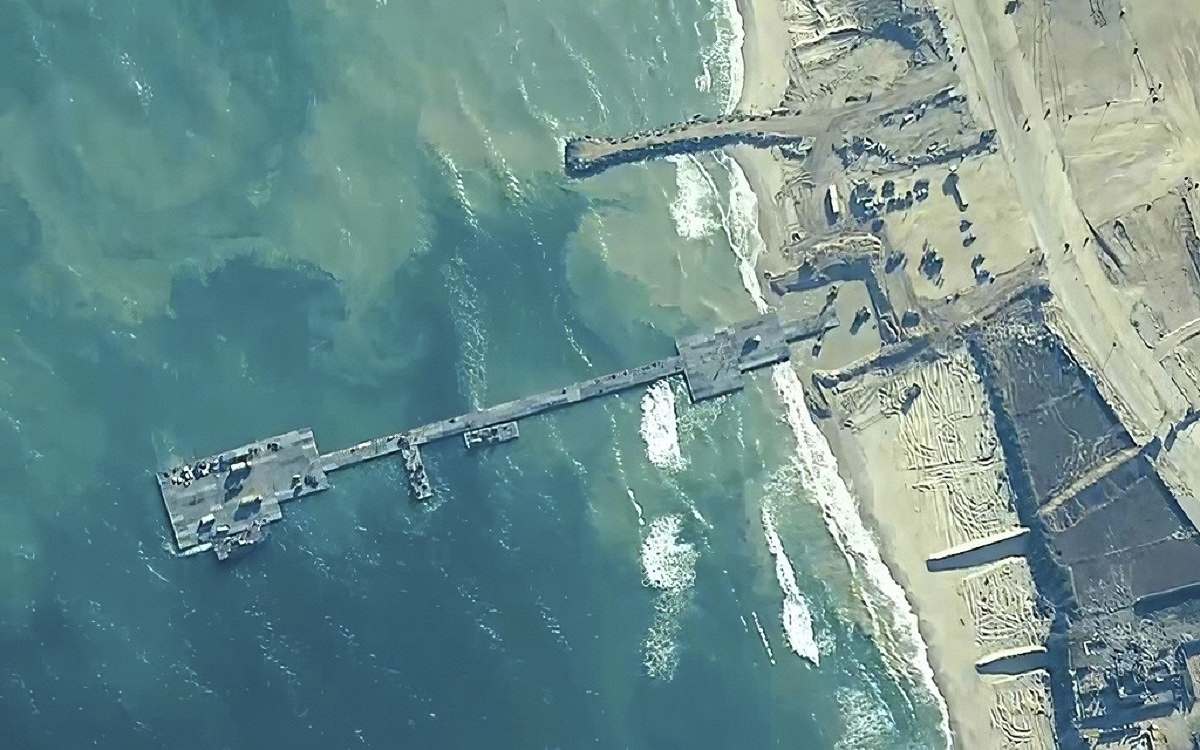US-built Pier in Gaza is Reconnected after Repairs, and Aid will Flow Soon, US Central Command Says

The image provided by U.S, Central Command, shows U.S. Army soldiers assigned to the 7th Transportation Brigade (Expeditionary), U.S. Navy sailors assigned to Amphibious Construction Battalion 1, and Israel Defense Forces placing the Trident Pier on the coast of Gaza Strip on May 16, 2024.
10:23 JST, June 8, 2024
WASHINGTON (AP) — The U.S. military-built pier designed to carry badly needed aid into Gaza by boat has been reconnected to the beach in the besieged territory after a section broke apart in storms and rough seas, and food and other supplies will begin to flow soon, U.S. Central Command announced Friday.
The section that connects to the beach in Gaza, the causeway, was rebuilt nearly two weeks after heavy storms damaged it and abruptly halted what had already been a troubled delivery route.
“Earlier this morning in Gaza, U.S. forces successfully attached the temporary pier to the Gaza beach,” Vice Adm. Brad Cooper, deputy commander of U.S. Central Command, told reporters by phone Friday. “We expect to resume delivery of humanitarian assistance from the sea in the coming days.”
Cooper said operations at the reconnected pier will be ramped up soon with a goal to get 1 million pounds (500 tons or 450 metric tons) of food and other supplies moving through the pier into Gaza every two days.
The pier was only operational for a week before a storm broke it apart, and had initially struggled to reach delivery goals. Weather was a factor, and early efforts to get aid from the pier into Gaza were disrupted as civilians desperate for food stormed the trucks that aid agencies were using to transport the food to the warehouses for distribution.
However, before it broke apart the pier had been gradually increasing aid movement each day. Cooper said Friday that the lessons learned from that initial week of operations made him confident higher levels of aid throughout could be attained now.
The U.S. Agency for International Development said in a statement it was working with other U.S. government colleagues and humanitarian partners on the ground in Gaza to ensure that aid from the pier “can safely and effectively resume movement, which we expect in the coming days.”
A large section of the causeway broke apart May 25 as heavy winds and high seas hit the area, and four Army vessels operating there went aground, injuring three service members, including one who remains in critical condition. The damage was the latest stumbling block in what has been a persistent struggle to get food to starving Palestinians during the 8-month-old Israel-Hamas war.
The maritime route for a limited time had been an additional way to help get more aid into Gaza because the Israeli offensive in the southern city of Rafah has made it difficult, if not impossible at times, to get anything through land routes, which are far more productive. Israel’s Rafah military operations and military strikes in northern Gaza had also temporarily halted U.S. airdrops of food.
Cooper said Friday the U.S. also expects to resume those airdrops in the coming days.
President Joe Biden’s administration has said from the start that the pier wasn’t meant to be a total solution and that any amount of aid helps.
After the May 25 storm damage to the causeway, large sections were disconnected and moved to an Israeli port for repairs. In addition, two of the U.S. Army boats that went aground during the same bad weather near Ashkelon in Israel have been freed.
Two other Army boats two beached onto the Gaza shoreline took on a lot of water and sand and the Israeli Navy has been helping with the repairs, Pentagon spokeswoman Sabrina Singh said.
Biden, a Democrat, announced his plan for the U.S. military to build a pier during his State of the Union address in early March, and the military said it would take about 60 days to get it installed and operational. The initial cost was estimated at $320 million, but Singh said earlier this week that the price had dropped to $230 million, due to contributions from Britain and because the cost of contracting trucks and other equipment was less than expected.
It took a bit longer than the planned two months for installation, with the first trucks carrying aid for the Gaza Strip rolling down the pier on May 17. Just a day later, crowds overran a convoy of trucks as they headed into Gaza, stripping the cargo from 11 of the 16 vehicles before they reached a U.N. warehouse.
The next day, as officials altered the travel routes of the convoys, aid finally began reaching people in need. More than 1,100 tons (1,000 metric tons) of aid were delivered before the causeway broke apart in the storm, Pentagon officials said.
"News Services" POPULAR ARTICLE
-

American Playwright Jeremy O. Harris Arrested in Japan on Alleged Drug Smuggling
-

Japan’s Nikkei Stock Average as JGB Yields, Yen Rise on Rate-Hike Bets
-

Japan’s Nikkei Stock Average Licks Wounds after Selloff Sparked by BOJ Hike Bets (UPDATE 1)
-

Japanese Bond Yields Zoom, Stocks Slide as Rate Hike Looms
-

Japan’s Nikkei Stock Average Buoyed by Stable Yen; SoftBank’s Slide Caps Gains (UPDATE 1)
JN ACCESS RANKING
-

Keidanren Chairman Yoshinobu Tsutsui Visits Kashiwazaki-Kariwa Nuclear Power Plant; Inspects New Emergency Safety System
-

Imports of Rare Earths from China Facing Delays, May Be Caused by Deterioration of Japan-China Relations
-

University of Tokyo Professor Discusses Japanese Economic Security in Interview Ahead of Forum
-

Japan Pulls out of Vietnam Nuclear Project, Complicating Hanoi’s Power Plans
-

Govt Aims to Expand NISA Program Lineup, Abolish Age Restriction

























